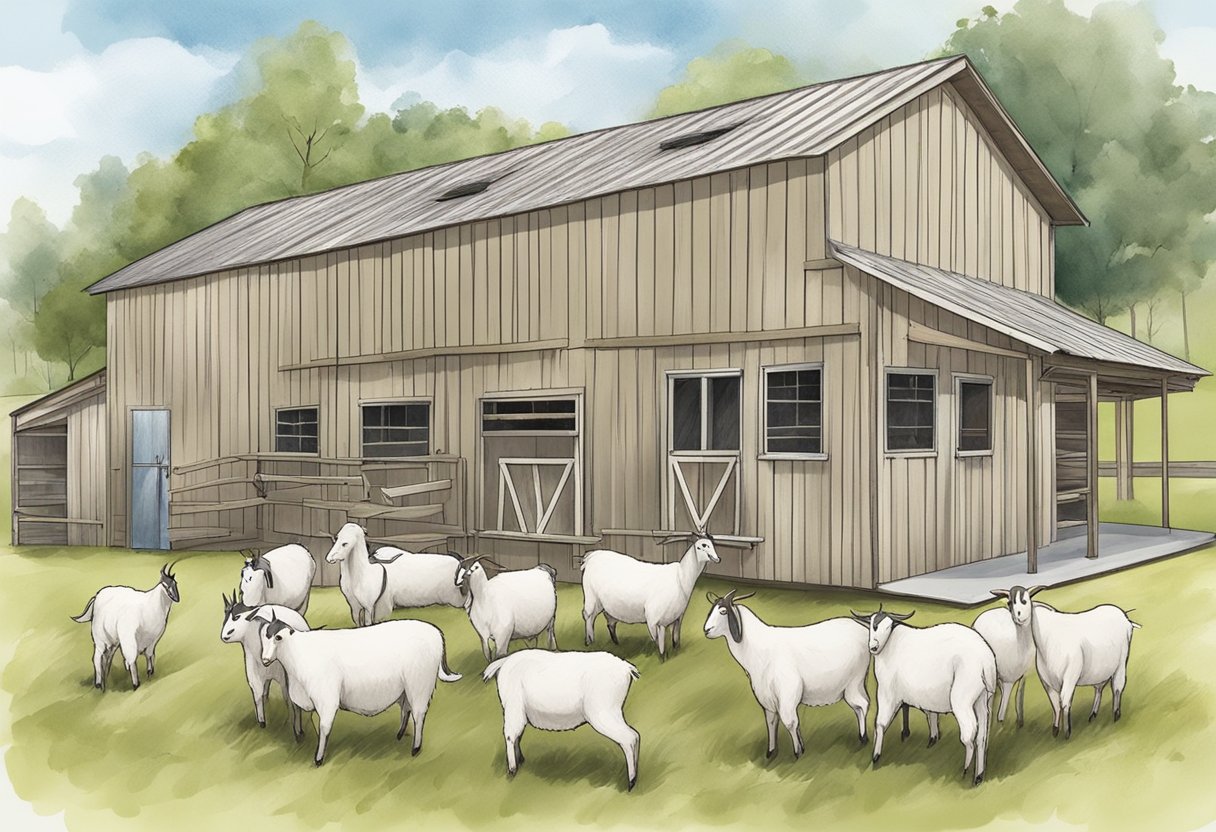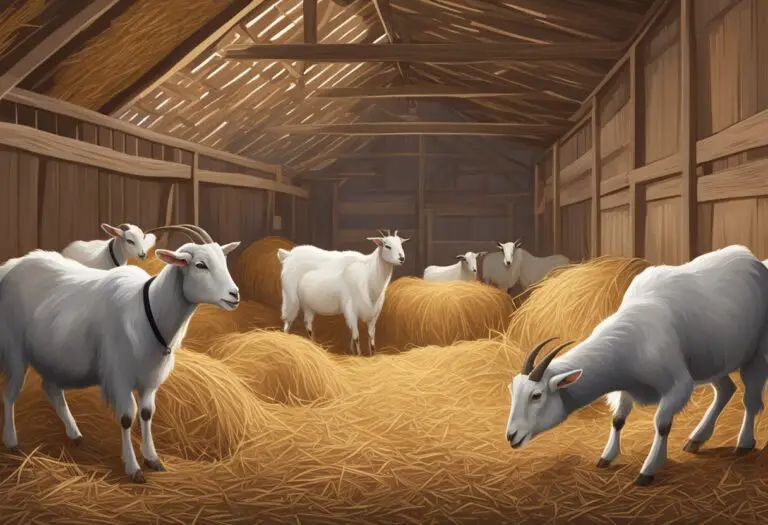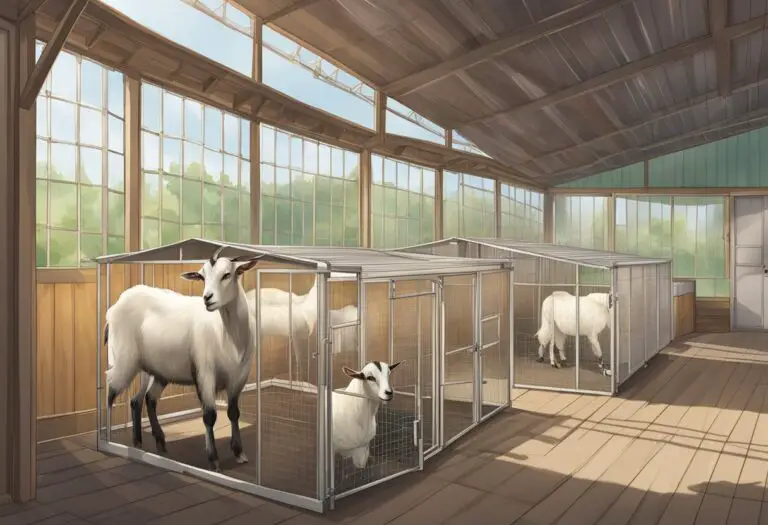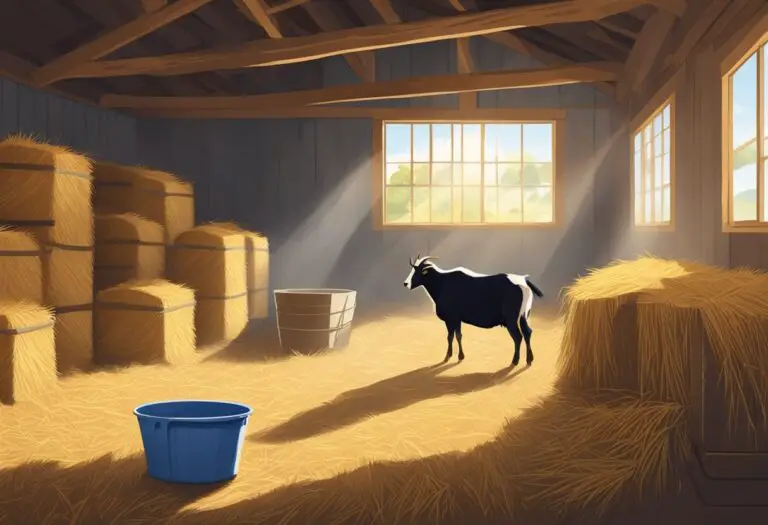How to Properly Ventilate a Goat Barn: Tips and Tricks
Proper ventilation is essential for maintaining a healthy and comfortable environment for goats in a barn. Good ventilation helps to reduce the buildup of harmful gases, moisture, and odors that can lead to respiratory problems, infections, and other health issues. In addition, proper ventilation promotes air circulation, which helps to regulate temperature and humidity levels in the barn.
There are several factors to consider when designing and maintaining a ventilation system for a goat barn. These include the size and layout of the barn, the number of goats being housed, and the climate and weather conditions in the area. Proper ventilation may involve a combination of natural and mechanical systems, such as windows, vents, fans, and air conditioning. It is important to regularly monitor and adjust the ventilation system to ensure that it is working effectively and efficiently.
Understanding Goat Barn Ventilation

Importance of Proper Ventilation
Proper ventilation is essential for the health and well-being of goats. Without adequate ventilation, a buildup of moisture, ammonia, and other harmful gases can occur, leading to respiratory problems, illness, and even death. Additionally, poor ventilation can lead to a buildup of heat and humidity, which can cause heat stress and reduce milk production.
Ventilation Basics for Goat Health
There are several key factors to consider when designing a ventilation system for a goat barn. These include:
- Airflow: Good ventilation requires adequate airflow throughout the barn. This can be achieved through the use of fans, vents, and open windows or doors. It’s important to ensure that air is circulating evenly throughout the barn and that there are no stagnant areas where moisture and gases can accumulate.
- Temperature: Goats are comfortable in temperatures between 40 and 70 degrees Fahrenheit. In order to maintain this temperature range, it may be necessary to use heaters or fans to regulate the temperature in the barn.
- Humidity: High humidity can lead to respiratory problems and other health issues for goats. It’s important to ensure that the barn is well-ventilated to reduce humidity levels.
- Ammonia levels: Ammonia is a byproduct of urine and can build up quickly in a poorly ventilated barn. High levels of ammonia can cause respiratory problems and other health issues for goats. Regular cleaning and proper ventilation can help to reduce ammonia levels.
By considering these factors and designing a ventilation system that meets the specific needs of your goat herd, you can help to ensure that your goats are healthy, comfortable, and productive.
Designing the Ventilation System

Assessing Barn Size and Layout
Before designing a ventilation system for a goat barn, it is important to assess the size and layout of the barn. The number of goats, the size of the barn, and the layout of the barn all play a crucial role in determining the type of ventilation system required.
Types of Ventilation Systems
There are two main types of ventilation systems used in goat barns: natural ventilation and mechanical ventilation. Natural ventilation relies on natural air movement through the barn, while mechanical ventilation uses fans and other equipment to move air through the barn.
Natural ventilation is often preferred for smaller barns with good airflow. Mechanical ventilation is more suitable for larger barns or barns with poor airflow. However, mechanical ventilation can be more expensive to install and maintain.
Positioning of Inlets and Outlets
The positioning of inlets and outlets is crucial to ensure proper ventilation in a goat barn. Inlets should be located near the floor to allow fresh air to enter the barn, while outlets should be located near the roof to allow warm, stale air to escape.
It is also important to consider the prevailing wind direction when positioning inlets and outlets. Inlets should be located on the side of the barn facing the wind, while outlets should be located on the opposite side.
In summary, designing an effective ventilation system for a goat barn requires careful consideration of the barn size and layout, the type of ventilation system required, and the positioning of inlets and outlets. By taking these factors into account, goat farmers can ensure a healthy and comfortable environment for their animals.
Maintaining Air Quality

Monitoring Humidity and Temperature
Proper ventilation in a goat barn is crucial to maintain good air quality. One important aspect of this is monitoring humidity and temperature levels. High humidity levels can lead to the growth of mold and bacteria, which can be harmful to both the goats and their caretakers. On the other hand, low humidity levels can cause respiratory issues in goats. It is recommended to keep the humidity levels between 40-60% and the temperature between 45-75°F.
To monitor humidity and temperature, a hygrometer and thermometer can be used. These instruments should be placed at goat level and in areas where ventilation is most important, such as near the fans or air inlets. Regularly checking these levels can help ensure that the barn environment is optimal for the goats.
Controlling Airflow
Controlling airflow is another important factor in maintaining good air quality in a goat barn. Proper airflow helps to remove excess moisture, ammonia, and carbon dioxide from the barn. It also helps to prevent the buildup of dust and other airborne particles that can cause respiratory issues in goats.
To control airflow, it is important to have a well-designed ventilation system. This system should include fans, air inlets, and exhaust vents. Fans should be placed strategically to move air throughout the barn. Air inlets should be placed near the ground to allow fresh air to enter the barn. Exhaust vents should be placed near the ceiling to allow stale air to exit the barn.
Regular Maintenance Checks
Regular maintenance checks are necessary to ensure that the ventilation system is working properly. This includes checking the fans, air inlets, and exhaust vents for any damage or blockages. It is also important to clean the barn regularly to remove any buildup of dust or other debris that can clog the ventilation system.
In addition to regular maintenance checks, it is important to have a backup plan in case of power outages or other emergencies. This can include having backup generators or battery-powered fans to ensure that the ventilation system continues to work properly even during an outage.
By monitoring humidity and temperature levels, controlling airflow, and performing regular maintenance checks, goat owners can ensure that their barns have good air quality. This can help to prevent respiratory issues and other health problems in goats, as well as improve the overall productivity and well-being of the herd.
Natural Ventilation Techniques

Utilizing Wind Patterns
One of the most effective natural ventilation techniques for goat barns is utilizing wind patterns. This technique involves positioning the barn in a way that takes advantage of the prevailing wind direction. The windward side of the barn should have openings to allow for fresh air to enter, while the leeward side should have openings to allow for stale air to exit. This creates a natural flow of air through the barn, which helps to regulate temperature and reduce humidity.
Strategic Opening Placement
Another natural ventilation technique for goat barns is strategic opening placement. This technique involves strategically placing openings throughout the barn to encourage airflow. Openings should be located at the highest point of the barn to allow hot air to escape, while also being positioned to take advantage of prevailing wind patterns. It is important to ensure that openings are not too large, as this can cause drafts and make the barn uncomfortable for the goats.
In addition to these natural ventilation techniques, it is important to keep the barn clean and free of obstacles that could impede airflow. Regular cleaning and maintenance of the barn can help to ensure that the ventilation system is working effectively. By utilizing these natural ventilation techniques, goat owners can create a comfortable and healthy environment for their animals.
Mechanical Ventilation Solutions

Fans and Exhaust Systems
Mechanical ventilation is an effective way to ensure proper air circulation in a goat barn. Fans and exhaust systems are two common solutions that can be used to improve the air quality in the barn. Fans can be used to move air in and out of the barn, while exhaust systems can be used to remove stale air and moisture.
Fans can be installed in the barn to move air in and out of the barn. This can be done by installing fans at opposite ends of the barn to create a cross-ventilation system. The fans should be positioned at a height of 8 to 10 feet to ensure that the air is circulated at the goat’s level. A fan with a diameter of 36 inches can be used for a barn with a size of 20 feet by 20 feet.
Exhaust systems can be used to remove stale air and moisture from the barn. This can be done by installing exhaust fans at the top of the barn to remove hot and moist air. The exhaust fans should be positioned in a way that they can remove air from the barn without creating a draft that can affect the goats.
Automated Climate Control
Automated climate control is another mechanical ventilation solution that can be used in a goat barn. This system uses sensors to monitor the temperature and humidity levels in the barn and automatically adjusts the ventilation system to maintain optimal conditions.
Automated climate control systems can be set up to control both the fans and exhaust systems in the barn. This system can be set up to turn on the fans when the temperature rises above a certain level and turn on the exhaust fans when the humidity levels rise above a certain level. This system can help to maintain optimal conditions in the barn, which can improve the overall health and productivity of the goats.
In conclusion, mechanical ventilation solutions such as fans and exhaust systems, as well as automated climate control systems, can be used to improve the air quality in a goat barn. These solutions can help to maintain optimal conditions in the barn, which can improve the overall health and productivity of the goats.
Addressing Seasonal Changes

Adjustments for Summer
During the summer months, it is important to ensure that the goat barn is well-ventilated to prevent heat stress and promote good air quality. This can be achieved by opening windows and doors to allow for cross-ventilation, and installing fans to improve air circulation. It is also important to provide shade and access to clean, cool water to help goats regulate their body temperature.
In addition to these measures, it may be necessary to adjust the ventilation system to account for changes in temperature and humidity. This can be done by monitoring the temperature and humidity levels inside the barn and adjusting the ventilation accordingly. For example, if the temperature inside the barn is too high, the ventilation system can be adjusted to increase airflow and reduce heat buildup.
Preparations for Winter
During the winter months, it is important to ensure that the goat barn is well-insulated to prevent drafts and maintain a comfortable temperature for the goats. This can be achieved by sealing any gaps or cracks in the walls and roof, and installing insulation to help retain heat.
In addition to these measures, it may be necessary to adjust the ventilation system to account for changes in temperature and humidity. This can be done by monitoring the temperature and humidity levels inside the barn and adjusting the ventilation accordingly. For example, if the temperature inside the barn is too low, the ventilation system can be adjusted to reduce airflow and retain heat.
Overall, proper ventilation is essential for maintaining a healthy and comfortable environment for goats. By addressing seasonal changes and making necessary adjustments to the ventilation system, goat owners can ensure that their animals are well-cared for year-round.
Health and Safety Considerations

Preventing Respiratory Issues
Proper ventilation is essential to prevent respiratory issues in goats. Poor ventilation can cause respiratory problems such as pneumonia, which can be fatal. It is important to ensure that the barn has adequate ventilation to prevent the buildup of dust, mold, and other harmful particles that can cause respiratory issues.
To prevent respiratory issues, it is recommended to use fans to circulate air throughout the barn. Fans should be placed strategically to ensure that air is moving throughout the barn. Additionally, it is important to keep the barn clean and free of dust and debris that can cause respiratory issues.
Minimizing Ammonia Levels
Ammonia levels can build up in a goat barn and cause health issues for the goats. High levels of ammonia can cause respiratory problems, eye irritation, and other health issues. To minimize ammonia levels, it is important to keep the barn clean and well-ventilated.
Regularly cleaning the barn and removing manure and urine can help to minimize ammonia levels. Additionally, it is recommended to use absorbent bedding materials such as straw or wood shavings to help absorb urine and minimize ammonia levels.
Overall, proper ventilation and cleanliness are essential to maintaining the health and safety of goats in a barn. By taking the necessary steps to prevent respiratory issues and minimize ammonia levels, goat owners can ensure that their animals are healthy and happy.
Cost-Effective Ventilation Strategies

Energy Efficiency Tips
Proper ventilation is essential for the health and well-being of goats in a barn. However, running fans and other ventilation systems can be costly. Here are some energy efficiency tips to help reduce the cost of ventilating a goat barn:
- Install a thermostat to regulate the temperature and control the fans automatically.
- Use fans with variable speed controls to adjust the air flow as needed.
- Install insulation in the walls and ceiling to reduce heat loss during the winter.
- Use natural ventilation by opening windows and doors to allow fresh air in and stale air out.
By implementing these energy efficiency tips, goat owners can reduce their energy consumption and save money on their electricity bills.
Budget-Friendly Practices
Not all goat owners have the budget for expensive ventilation systems. Here are some budget-friendly practices to help ventilate a goat barn:
- Install vents in the roof to allow hot air to escape naturally.
- Use a ridge vent to create a continuous air flow.
- Install windows or vents near the floor to allow cool air to enter the barn.
- Use fans to circulate the air and prevent stagnant air pockets.
These budget-friendly practices can help goat owners ventilate their barns without breaking the bank. By combining energy efficiency tips with budget-friendly practices, goat owners can create a healthy and comfortable environment for their goats while keeping costs down.







